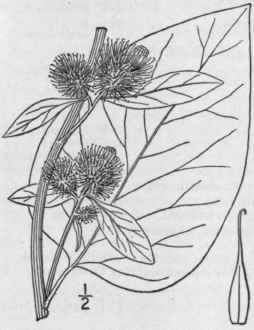103. Arctium L. Sp. Pl. 816. 1753
Description
This section is from the book "An Illustrated Flora Of The Northern United States, Canada And The British Possessions Vol3", by Nathaniel Lord Britton, Addison Brown. Also available from Amazon: An Illustrated Flora of the Northern United States, Canada and the British Possessions. 3 Volume Set..
103. Arctium L. Sp. Pl. 816. 1753
Large coarse branching, rough or canescent, mostly biennial herbs, with broad alternate petioled leaves, and rather large heads of purple or white perfect tubular flowers, racemose, corymbose or paniculate at the ends of the branches. Involucre subglobose, its bracts rigid, lanceolate, tipped with spreading or erect hooked bristles, imbricated in many series. Receptacle flat, densely bristly. Corollas tubular with 5-cleft limbs. Filaments glabrous. Anthers sagittate at the base. Achenes oblong, somewhat compressed and 3-angled, ribbed, truncate. Pappus of numerous short serrulate scales. [Greek, bear, from the rough involucre.]
About 6 species, natives of Europe and Asia, readily distributed, their burs adhering to animals. Type species: Arctium Lappa L.
Bracts of the involucre densely cottony; heads corymbose.
1. A. omentosum.
Bracts of the involucre glabrous, or slightly woolly.
Involucre 1' broad or more; inner bracts equalling or exceeding the flowers.
2. A. Lappa.
Involucre 6"-9" broad; inner bracts not exceeding the flowers.
3. A. minus.
1. Arctium Tomentosum (Lam.) Schk. Woolly Or Cottony Burdock
Fig. 4633
Lappa tomentosa Lam. Encycl. 1: 377. 1783.
Arctium tomentosum Schk. Bot. Handb. 3: 49. 1803.
Arctium Lappa var. tomentosum A. Gray, Syn. Fl. 1: Part 2, 397. 1884.
Similar to the following species; heads 8"-10" broad, corymbose at the ends of the branches, mostly long-peduncled; bracts of the involucre densely cottony, the inner ones erect and somewhat shorter than the flowers.
In waste places, Massachusetts to southern New York. Adventive from Europe. July-Aug.

2. Arctium Lappa L. Great Bur, Burdock Or Clotbur
Fig. 4634
Arctiuni Lappa L. Sp. Pl. 816. 1753.
Lappa major Gaertn. Fruct. & Sem. 2: 379. pl. 162. 1802.
Stem much branched, 4°-9° high. Leaves thin, broadly ovate, pale and tomentose-canescent beneath, obtuse, entire, repand or dentate, mostly cordate, the lower often 18' long; petioles solid, deeply furrowed; heads clustered or subcorymbose, sometimes long-peduncled, 1'-1 1/2' broad; bracts of the involucre glabrous or nearly so, their spines all spreading, the inner ones equalling or exceeding the flowers; corolla-tube longer than the limb.
In waste places, New Brunswick and Ontario to southern New York, and locally in the interior. Not nearly as common as the next species in the Middle States. Naturalized from Europe. Other names are cockle-bur, cockle-button, cuckold-dock, hurr-bur, stick-button, hardock, bardane, beg-gar's-buttons. July-Oct.


3. Arctium Minus Schk. Common Burdock
Fig. 4635
Arctium minus Schk. Bot. Handb. 3: 49. 1803.
Lappa minor DC. Fl. Fran. 4: 77. 1805.
Arctium Lappa var. minus A. Gray, Syn. Fl. 1: Part 2, 397. 1884.
Smaller than the preceding species, seldom over 5° high. Leaves similar, the lower deeply cordate; petioles hollow, not deeply furrowed; heads numerous, racemose on the branches, short-peduncled or sessile, 6"-9," broad; bracts of the involucre glabrous or slightly cottony, the spines of the outer ones spreading, those of the inner erect and shorter than the flowers; corolla-tube about as long as the limb.
In waste places, common nearly throughout our area, extending west to Colorado. Naturalized from Europe. Called also cuckoo-button. Leaves rarely laciniate or pinnatifid. July-Nov.
Continue to:


